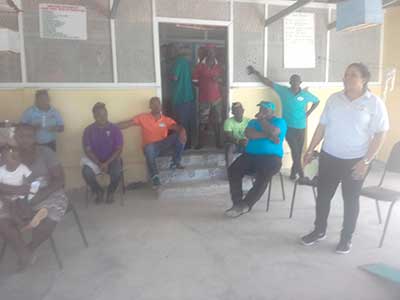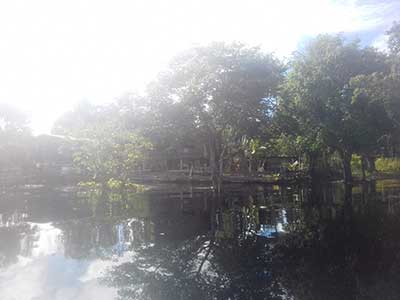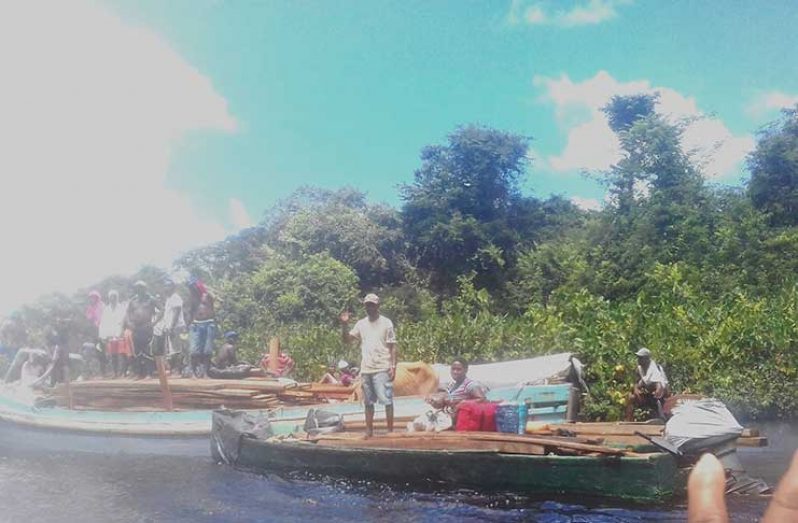FLOODWATERS at Bara Cara, Canje Creek, have resulted in the death of 30 sheep, reported Regional Executive Officer Ms. Kim Williams Stephen, during a verification visit to the community on Friday.
However, residents claimed that calves also died as a result of the high waters, which have extended to over 100 feet inland and has also damaged cash and other crops, while forcing domesticated and wild animals to higher lands.

The area has been flooded since May.
Williams-Stephen, who was accompanied by Director of Health Services, Region Six, Mr. Jevaughn Stephens, Medical Practitioner Dr. Radlay, veterinarian Dr. Hamwantie Nauth , Livestock Extension Officer Navendra Sookmangal, amongst other medical and regional staffers, told villagers, who had converged at the Bara Cara Health Centre, that the fact-finding impromptu visit was to have first-hand information of what is happening in their community and to render the necessary support .
Consequently, she said the veterinarian and team administered antibiotics, vitamins, and electrolytes to 136 sheep, 8 goats, 38 cows and 205 poultry.
Further, scores of patients were seen and treated for conjunctivitis, skin rashes, diarrhoea and vomiting, along with uncontrolled hypertension, amongst seniors.
In addition, the REO said, among relief items given over for the benefit of the members of the community were medications, dietary and janitorial supplies.
In an invited comment, Dr. Radlay opined that the high blood pressure was a result of poor management of the disease by the patients, who need to be educated further on their condition.

‘If they cannot manage the condition, then in the not-too-distant future we will have persons experiencing attacks of stroke, and it may be detrimental, considering the 60-mile distance by water to the New Amsterdam Hospital.’
In the meantime, 69-year-old Norman Amsterdam told the Guyana Chronicle that the water started to rise two months ago, and although the Community Development Council officials visited farmlands to assess damage, noting had been forthcoming.
The farmer claimed that it was the second time in his lifetime that he has experienced such severe flooding, whilst arguing that even in high tide, the water level has never risen to over five to seven feet inland. However, he cast the blame on the long, continuous rainfall.
Amsterdam’s losses include his cash crops, eddoes, plantains, cassava and his creole fowls .
Another resident, 27-year-old Kingsley Park, expressed concern over the cattle which have now turned to the surviving cultivation farms for sustenance, creating further difficulty for farmers who depend on their crops for their livelihoods.
‘But who will pay for damage incurred?’ he questioned. The water, he said, is contaminated. The outhouses are flooded. So, to avoid illnesses, we have to catch the rain water for drinking, cooking, bathing and washing purposes.
Meanwhile, Earla Amsterdam, age 47, complained about her losses which include a few acres of rice and corn. While the cultivation plot is not within commercial quantities, the woman says she depends on the produce to sustain her immediate and extended family.
Another resident, Fenton Liverpool, said he developed a pasture and was able to rescue most of his animals with the minimum loss of a few calves. Currently, he is assisting other residents with pasture land for their animals’ survival.
He said although he had noticed the Guyana Sugar Corporation irrigating the Torani Canal, the water was not receding, and suggested that nature would have to take its course.
However, medex Karl Amsterdam, a retiree on a three-year contract, said he had initiated a plan of action for water-borne diseases, and have been conducting weekly outreaches to other communities within the Baracara Health Centre catchment.
He noted that over the past two months, persons were treated mainly for conjunctivitis and skin rashes. However, he observed that with excrement from wild and domesticated animals and, humans which could be seen floating in the river, it makes it difficult to use the only available water, and residents now have to depend on the rainfall to supply their needs.
However, as some residents opted to remain in the flooded area, others took the opportunity to move their families and animals to the New Amsterdam township until the water recedes.




.png)









